#hessarian
Text
Andrastian Statues
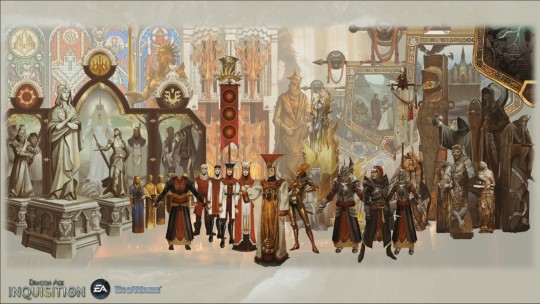
The purpose of this collection of statues is to show the Andrastian style depending on the region, the details in it, and how this may or may not influence other statues we saw in game. I also attempt to recollect some interpretations of them, although most of them are mostly based on speculations.
The current post contains the following set of statues:
Ferelden Style: Pre-Divine Andraste, Chasind Andraste, Ferelden warrior protector Andraste, The Maker, The Dwarf [?], Rider Maferath [?], Masferath Repentant, Hanged Masferath, Other Statues.
Orlesian Style: Rustic Maferath, Hessarian, Andraste; The Orlesian Warrior Andraste, The Stylised Orlesian Andraste, The Orlesian Andraste, The Orlesian Maferath, The Orlesian Havard, and the Orlesian Hessarian; The Weight of War
Free Marches Style: The Free Marches Hessarian, The Free Marches Andrastian Warriors [?]
Unknown Style: The Skull with sword, The Guide, Guardians of the Path / The Watcher.
[This post belongs to the series “Analysis and speculation of Statues”]
Ferelden Style
Pre-Divine Andraste
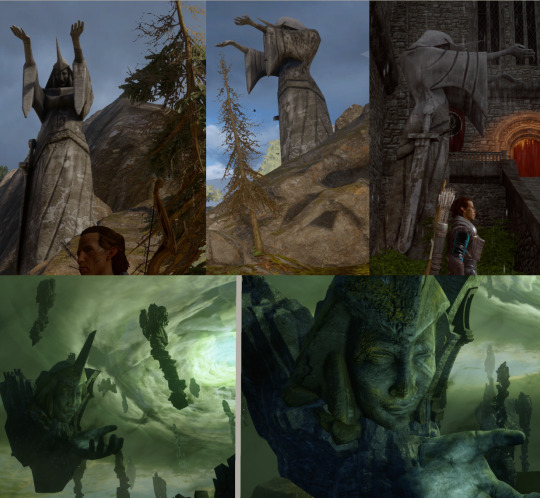
One of the most iconic statues in DAI.
It’s present all over Ferelden, specially in big, colossal statues along the paths of Hinterlands. They are so big that sometimes one can overlook them unless you look upwards [check Hinterlands: Statues, paintings, and structures found in the open].
In Skyhold, we can find this statue in a small version in the local chapel, which triggers the note Bride of the Maker.
Thanks to the DLC Jaws of Hakkon [Main Chamber of Razikale’s Reach], we know that this statue belongs to a pre-divine time. It is probably one of the oldest representations of Andraste we have in-game.
As usual, she has a one-spike helm that has strong resemblances to Flemeth’s tiara, and to Humanoid Mythal statue, Dragon Mythal statue, and the Ferelden Wyvern.
She has a sword in her hip.
Her sleeves and skirt have long lines that emulate folding. It’s a style we saw in statues that were considered “elvhen” in-game [for example, the Elven Archers or The guide]. But we can see this became an Andrastian style since we also see it in the Blocky bearded humanoid.
Her gigantic hands have been used in several elvhen places, and I wonder how meaningful these are: these hands appear in Exalted Plains: the Dead Hand as well as in the Shattered Library, holding eluvians. Is this a mere reuse of resources or hides some lore in it? We know DAI is less lazy about this than previous games.
This statue is curiously aligned with Humanoid Mythal statue in the Fade, as well as with the Imperial Highway Columns [check The Raw Fade: Part 1]. A Design choice that keeps me wondering if it hides some meaning in it.
Chasind Andraste
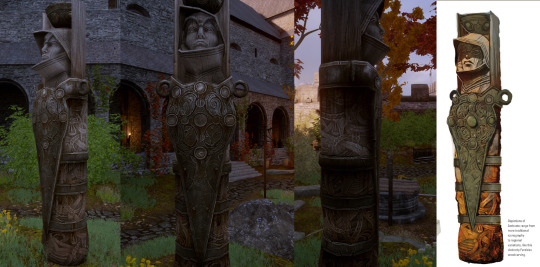
It has the design of a totem.
Its relief is very intricate.
She is represented as a protector warrior due to the strong presence of the shield on it.
We can suspect this statue is also ancient, and you can see that it has similar style to the Alamarri Monolith with swirls we find all over Hinterlands.
If you pick the Chantry-related garden in Skyhold, this statue appears in it and the archivist Banon will mention details about it in The Women of All War. He claims it’s Chasind, not original from Skyhold, brought by Ferelden into the castle. He also suggest it’s a re-usage of an ancient totemic statue.
This last comment streghtens the idea that ancient Andrastian art tends to be done over or using/co-opting statues from previous civilisations.
Ferelden warrior protector Andraste
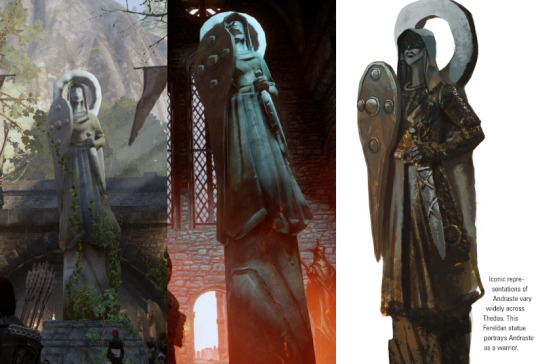
Another classic representation of Andraste in game.
It’s Ferelden style.
She is represented as a warrior [holding shield and sword] but also as a divine entity [I suspect the ring behind her works as a rustic design of a halo].
There is a chance that the thick “halo” could be an adaptation from another icon we saw among the Elvhenan design: the Golden Ring. How is this possible? I think it’s not too strange considering how deeply related to the elves the Avvar are. If we think that part of this culture comes from the Alamarri, one could guess that through the elvhen lover that Thrydda had, some elvhen presence has been around this culture to incorporate elvhen iconography in their own art, translated later into something of this shape.
The Maker
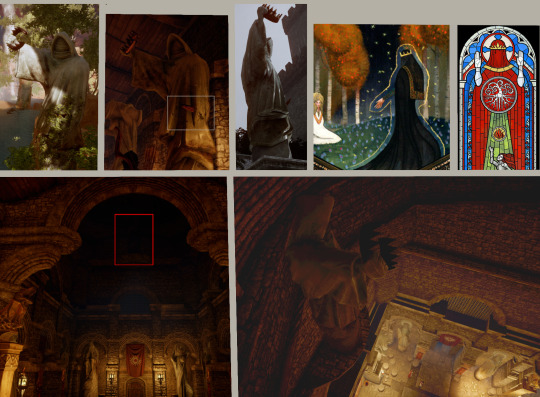
This mysterious figure has no face, in fact, it looks like bandaged. In his right hand holds a crown, while in his left hand, a dagger. The outfit is a very simple robe.
The dagger is quite curious for a representation of the Maker.
This statue took me a long whlie to identify. In early posts I kept calling it Faceless figure holding a crown. I came to the conclusion it is the Maker.
This statue appears always within the context of the Andrastian statues, so it could not be asumed in any other way than related to the Andraste Myth. In the posts Andrastian Design: Stained Glasses and Andrastian Design: Tapestry and Tryptich, we can see that a figure with no face and wearing a crown of similar characteristics is represented as the Maker. These are my main arguments to be confident about this identification.
In Hinterlands, he appears in the main hall of Haven very high upon the hall, hidden in the shadows, in a room filled with andrastian iconography, which reinforces the idea that it represents an entity that is above all of them, Andraste included. Another confirmation of being the Maker.
It also appears in the Tyrdda Bright-Axe Path, which has a mixture of statues, and in Forbidden Oasis, when the place was took by the Andrastian forces. It also appears in the mysterious Hinterlands: The Unknown Ruin. Other more natural and Andraste-related places where we find it: Redcliffe - Future, Therinfal Redoubt, Western Approach: Adamant Fortress.
The Dwarf [?]

This figure was tag along the blog as Blocky bearded humanoid. It is found in the main hall of the Templar building of Therinfal Redoubt and in the corridors of Redcliffe - Future
The design of this statue feels closer to the pre-divine Andraste. Maybe it has some influence of the Alamarri style.
The long lines on sleeves and chest seem to suggest similarity in style with the pre-divine Andraste but also with the elvhenan statues such as the Elven Archers, or The guide.
Its face seems to show a big smile, but if you see it with more detail, it may also represent a long, long beard. The broad constitution, the big ears, the lack of hair, and the prominent beard seem to suggest a golem-like or dwarven representation.
I can’t say I can identify this figure in the Andrastian Myth, but it’s related to the Andrastian Faith since it appears where there are other andrastian figures.
If this figure comes from the Alamarri and it was co-opted by the Andrastian faith, I could suspect that may be related to the dwarven culture that Alamarri had. If we remember Tyrdda Bright-Axe Path, she had a child with a dwarven prince. The Chasind also had mixed descendants of humans and dwarves. So, if it’s an alamarri statue co-opted by the Chantry, it could not be strange for it to be a dwarf. These details may indicate that the Alamarri had a deeper relationship with not only elvhen, but also dwarves, and this aspect appeared in the art until co-opted by the andrastian faith resulting in this figure.
Rider Maferath [?]

This statue appears only in Fallow Mire. Although, the same statue appears riding a horse in Crestwood: surface. Maybe it’s a mere reuse of resources.
It has a similar design to the Blocky bearded humanoid.
It represents a man with a beard, and its angular design may suggest similar time and style than the previous one.
More details in the section Other Statues from this post.
Masferath Repentant

Mostly seen in the region of Ferelden [although, you can find it too in Western Approach: Adamant Fortress]
This is the typical Ferelden statue of Masferath, regretting his betrayal.
He is sitting on a stone which has a design of a snake surrounding it, representing the Tevinter influence or deal he made with the Archon before handing over his wife.
The helm in this statue has a C-shape, which I find very similar in design to the Tevinter helms [check section “Outfits” in Patterns and Styles: Tevinter]. I’m not sure if this is mere coincidence, or it speaks of a common [dragon-inspired] origin source.
Hanged Masferath
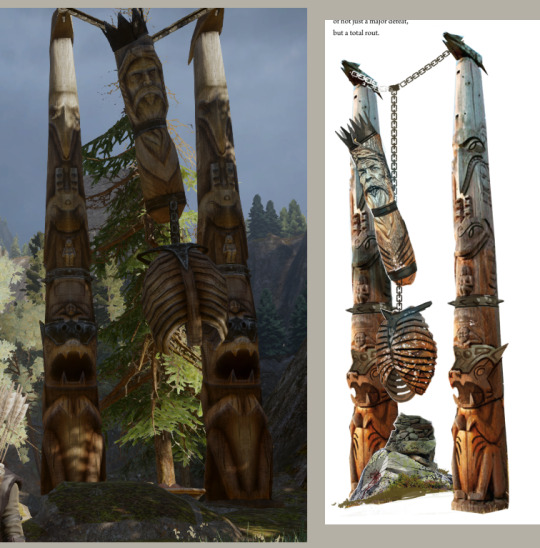
This totemic sculpture can be found in Hinterlands: Statues, paintings, and structures found in the open.
This is a Ferelden representation of Masferath being hanged. Clearly Ferelden has a strong sentiment with his betrayal.
The totemic structure seems to show mabaris at its base, followed by two different kinds of birds or maybe it’s a dragon [hard to say].
The top of these totems keeps bringing my attention: I can’t stop thinking there may be some link with the Tevinter metallic statue that I called “Tevinter bird”, found in Ferelden in the underground region of Crestwood: Flooded Caves.
Other Statues
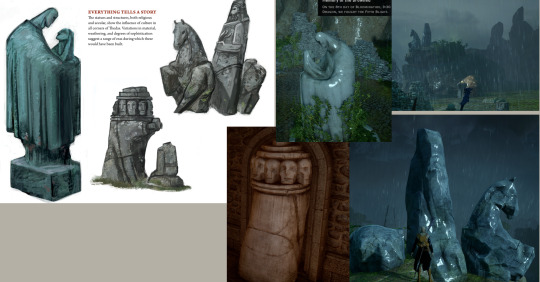
The couple can be found in Hinterlands: Redcliffe - Present, as a symbol to remember those who died in DAO-Redcliffe. It can also be found in Crestwood: surface as a memory statue of the drown, and in Frostback Basin [DLC]: Nigel’s point, as a memory statue of Ameridan’s friends: The templar Haron and the dwarf Orinna. It feels more like a reuse in most cases since it’s a strange statue to represent "fallen/lost people”. Certainly we can assume it’s Ferelden made.
The horse with the rider seems to have, as we see in its drawing from the book Art of Inquisition, a lot in common with the previous statue I called “Rider Masferath”. The horse has been removed in some other places to only let the human figure stay. It can be seen in Fallow Mire without his horse, and in Crestwood: surface. Sometimes the rider is not well chiselled in the stone.
The vessel with many faces is only seen once in the game, in the The Darvaarad - Part2. We know the Qunari took this castle and put a lot of statues that they gathered around the world. However, this statue of many faces looks like it belonged to the inner corridors of the castle, implying the castle per ser may have been Ferelden, or elvhen in origin, but repurposed by Ferelden later. In the game we only see the “back” part of it, while in the book Art of Inquisition, we can see the full statue, which implies a beheaded figure. Maybe it’s the representation of a jury. It could also be interpreted as an entity that puts “the right head” into the people, suiting the Qunari and their Qun philosophy, but this interpretation would make me question why it is so related to Ferelden art in the Art Book.
Orlesian Style
Rustic Maferath, Hessarian, Andraste
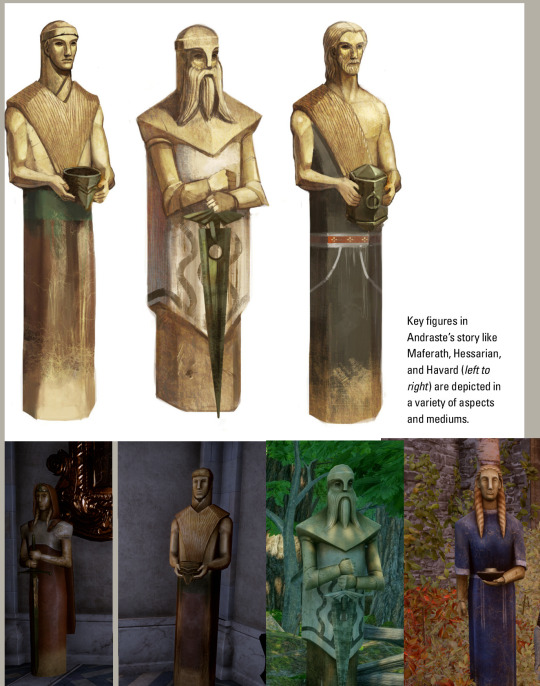
A bit distant to the style of the Blocky bearded humanoid, we have these series of statues representing typical characters from the Andrastian Myth.
They are mostly located in different areas all over Orlais [or inside the Skyhold if you pick an Andrastian garden].
We find Andraste, in blue and red [I’m assuming one is the bride of the Maker, while the other is the warrior protector of her people]
Masferath is carrying a crown (?) in his hands, and Hessarian is holding the Sword of Mercy.
These seem to belong to an Orlesian style but rustic or more “popular”. They give me the impression that were made by the working class people who could not afford realistic artists to sculpt them in stone.
They seem to be made out of wood.
The Orlesian Warrior Andraste

Unlike the previous one, this Orlesian statue is made out of stone and is bigger, more detailed, and realistic. It seems to appear in rich/high class places.
It also appears in Emerald Graves: Din'an Hanin, which may represent the influence of the Andrastian faith among the Ancient Dalish when the Dales was their Kingdom land granted by Andraste herself.
This statue presents Andraste as a warrior: she is wearing a detailed armour, a big sword, and, curiously, a helm that has no iconic single-spike. However, I can see some similarities in the armour design to Flemeth’s armour or the armour used by Humanoid Mythal statue.
Due to the strong similarities in style, this statue belongs to the same group than the Orlesian Andraste, Orlesian Maferath, Orlesian Havard, and Orlesian Hessarian.
The Stylised Orlesian Andraste

Another over-detailed statue of Andraste made out of Stone which appears in wealthy places.
The whole design of Andraste has a strong similarity to Tyrdda Bright-Axe, which may suggest that this statue may have a strong alamarri influence, mixing Andraste tale with the representation of Tyrdda.
The icon that represents the sun, ironically, has a strong similarity with the statue I called Sun-head creature, deeply related to the Elvhenan and, potentially, to Tevinter and its old dragon gods. This may imply that this statue may have collected several icons and details from different cultures and faiths to gather them in the cult to Andraste. This process is well known in human History, where the forced religion tries to blend with the local ancient one to produce an assimilation of the new faith.
The Orlesian Andraste
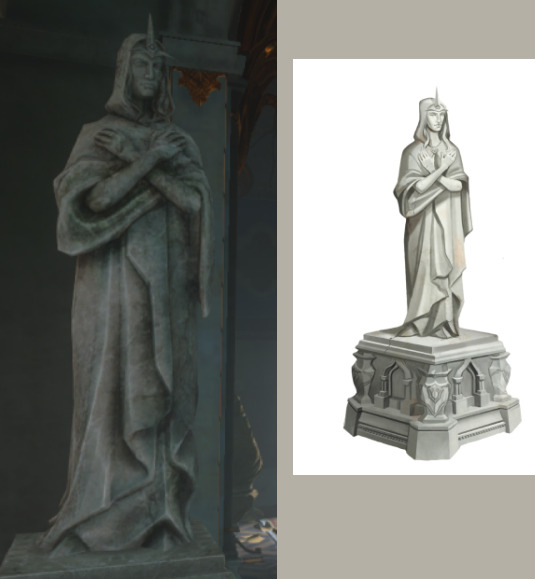
This Orlesian statue is made out of stone and is bigger and a lot more detailed and realistic that the “wooden” sculptures.
It tends to appear in wealthy places as well as inside the Chantries of the game.
It represents mostly the divine Andraste and the bride of the Maker, without any element of her warrior side.
She has a one-spike helm that has strong resemblances to Flemeth’s tiara, Humanoid Mythal statue, Dragon Mythal statue, and the Ferelden Wyvern.
Due to the strong similarities in style, this statue belongs to the same group than the Orlesian Warrior Andraste, Orlesian Maferath, Orlesian Havard, and Orlesian Hessarian.
The Orlesian Masferath
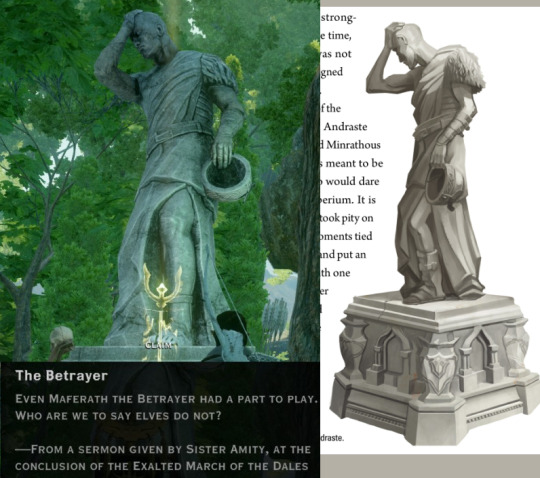
It is called “The Betrayer”.
We see the man worried, grabbing his own head, showing the weight of his own betrayal. He keeps the crowd of his leadership of the Alamarri in his hand since the Chantry tale says that he betrayed Andraste out of jealousy because she was more important than him among their people. I always questioned this since he was the one commanding the armies and their people into Tevinter, and he may have chosen the “lesser bad” option [read the The Chantry and the Mythology of the Chant of Light for more details].
Due to the strong similarities in style, this statue belongs to the same group than the Orlesian Warrior Andraste, Orlesian Andraste, Orlesian Havard, and Orlesian Hessarian.
The Orlesian Havard

Havard is shown here with avvar clothings [fur-based].
He is carrying the urn of Andraste’s ashes that will be placed in Haven and will become later the Temple of Andraste [DAO].
We know thanks to the notes triggered in it that this statue seems to represent Havard but its appearance was based on a noble’s lover [check it in Emprise du Lion: Pools of the Sun].
Due to the strong similarities in style, this statue belongs to the same group than the Orlesian Warrior Andraste, Orlesian Andraste, Orlesian Maferath, and Orlesian Hessarian.
The Orlesian Hessarian

He is holding the sword that will be called the Sword of Mercy, used to kill Andraste in the pyre so she could not suffer anymore.
His hat has a bent T-shape that we can see in many other helms of Tevinter warriors in the section of “outfits” in Patterns and Styles: Tevinter.
Due to the strong similarities in style, this statue belongs to the same group than the Orlesian Warrior Andraste, Orlesian Andraste, Orlesian Maferath, and Orlesian Havard.
The Weight of War

This statue was tagged in this blog as Man holding bigger head for a long while.
It has appeared in Forbidden Oasis, Redcliffe - Future, and in Orlais: Winter Palace.
Thanks to the constant presence of Andrastian-themed art around it, I could finally assume that this statue belongs to Andrastian art in Orlesian style.
The main man has angular features, his ears are not visible since it looks like he is wearing a chain-mail. He uses scale-based pauldrons, and a robe. He is holding a sword with one hand while the other holds a bigger head. By comparison with the state of the overall figure, we can assume that the bigger head has a lot of wounds and scars [meaning that this is part of the sculpture design and not a consequence of erosion].
Despite looking similar, the head in his hand and this man’s profile are different. The bigger head has a smaller, shrank nose.
The only significant shape in this statue that can give us a resemblance of a hint to whom it belongs is his belt, which has pointy ends. We had seen this pattern in two places: in Tevinter artefacts, such as the sacrificial burial, or in andrastian outfits.
It triggers a codex called The Weight of War which is a bit unreliable, since the person explaining this is an amateur historian, but it’s the only hint we have about this statue. The amateur historian implies that this statue may belong to a warrior with a philosophy similar to the Grey Wardens.
More details about this statue in the post Forbidden Oasis.
Free Marches Style
The Free Marches Hessarian
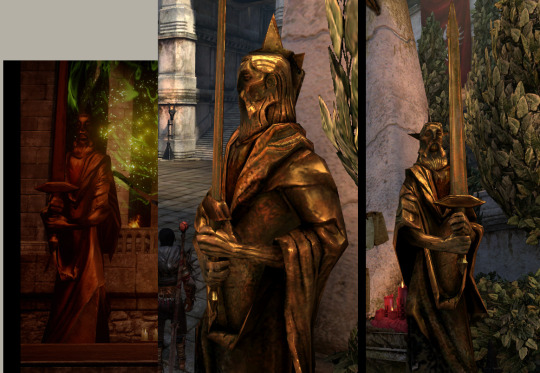
It appears mostly in the Templar fortress of Therinfal Redoubt
This statue has a strong resemblance to Tevinter art. It’s not only the dark metallic material used for the sculpture, which was strong similarities with Tevinter artefacts such as Thrummer, Water dispenser, Tevinter urn, Tevinter artefact with spikes, Tevinter golem or Claw of Dumat, but also the prominence of angles and pointy ends.
There is no codex associated with this sculpture, but I can guess it may represent Hessarian [the main Tevinter figure in the Andrastian Myth] since this statue has a version carrying a sword.
It has a long beard and hair.
This statue has also been present in DA2, specially in the Chantry district of Kirkwall [check it in Architecture of Kirkwall : The Chantry].
The Free Marches Andrastian Warriors [?]

It appears mostly in the Templar fortress of Therinfal Redoubt and in the Fade.
This statue has a strong resemblance to Tevinter art. It’s not only the dark metallic material used for the sculpture, which was strong similarities with Tevinter artefacts such as Thrummer, Water dispenser, Tevinter urn, Tevinter artefact with spikes, Tevinter golem or Claw of Dumat, but also the prominence of angles and pointy ends.
It’s wearing a typical DA2 Andrastian robe, but the helm has always brought my attention: it has a lot of more similarity to the Tevinter warriors than to the one-single spike helm of Andraste.
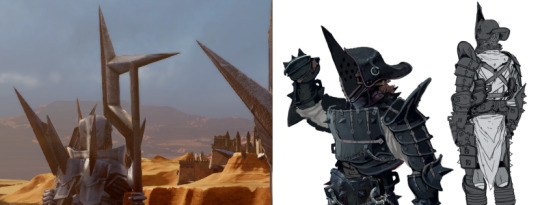
Its weapon also has a strong similarity to the weapon used by Tevinter golems, while its helm has strong similarities with the ones that belong to the Tevinter warriors. One may say that both of them, in fact, are representing the one-spike helm of Andraste.
The unmistakable identification with Andrastian faith is given by the robe: if we see the chest, we will see the pointy half sun on it, which was the main design of the outfit of Elthina and other chantry priests we saw in DA2.
Unknown Style
The Skull with sword
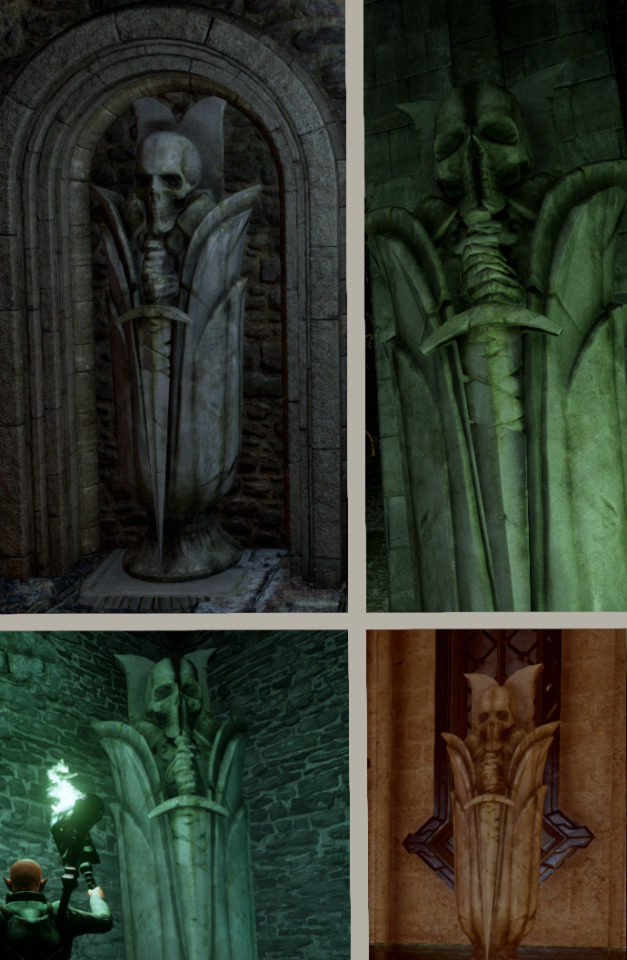
This is the statue that I called Skull bud with sword all over this blog.
The skull is quite long for a regular human. It holds a sword. The body seem to be inside a bud or a shell that may look like a flower bud but also as the shell of an insect/scarab.
This statue has always appeared within Andrastian contexts such as in Frostback Mountains - Haven [the basement], Hinterlands:Dead Ram Grove, or Ferelden: Therinfal Redoubt, but also in places where the Andrastian context is not that strong, but still yet reasonable to appear, for example in Hinterlands: The Unknown Ruin [overtaken by Andrastian faith lately, so far we see in the statues present in this room], or Emerald Graves: Din'an Hanin [which clearly shows how the Ancient Dalish allowed a certain level of assimilation of the Andrastian faith thanks to Andraste’s gift of the Dales]. However, we also find this statue in Western Approach: The Still Ruins, Viridis Walk and Inner Sanctum, which is a pre-blight Tevinter building, so one is inclined to think that this statue may have been Tevinter in origin, and somehow, adopted later by the Andrastian faith. Or maybe it’s just Elvhenan, taken first by Tevinter, and later by the Chantry [as we see this pattern repeats over and over with everything related to Tevinter].
One of the potential interpretations is that this sculpture represents a coffin, or a dead who is put to sleep in this position. The fact that this skull is inside a bud or an insect shell [in addition to the speculation that, like all what comes from Tevinter, was originally elvhenan] brings the possibility of being related to Uthenera and the mysterious codex of Vir Dirthara: A Flowering Imago that I tried to multi-interpret in several ways in Ancient Elven codices; Vir Dirthara.
So far I know, there is no codex associated with it, and we have only speculations about it.
Its style is not strongly similar to all these Andrastian statues, but the fact that it appears mostly within andrastian themed rooms, it’s hard not to bring it into this post.
However, I’m not confident about how to understand this statue and to what culture associated it with.
The Guide


It can be seen in three places only: Emerald Graves: The open pointing more or less towards Elgar’nan’s Bastion, on top of Stone-Bear Hold Avvars - Part 2 pointing out to the sea, and in the Fade, exactly in Flemeth’s Fade: Part 2, pointing the path towards Mythal/Flemeth.
It’s associated with the unreliable landmark called The guide [written by this orlesian scholar who lacks of deep knowledge of elven culture], which identifies it as an elvhen statue, but it has a lot of style similarities to the Blocky bearded humanoid and the pre-divine Andraste as well as to the Skull bud with sword. If we see the back of an Elven Archer statue, we can find line-based similarities too, so it’s hard to decide whether this is truly Elvhen in origin and co-opted by the Andrastian and repurposed later, or it truly belongs to the set of pre-divine statues we spoke above and this amateur scholar misunderstood it as Elvhenan.
The unreliable landmark links it to Falon’Din for the mere fact that it is pointing out a place, so it “guides”. If we overlook this pathetic logic, and we give it a remote chance for it to be elvhen, we should be careful to identify it with Falon’Din. First, Via Solas, we know that Falon’Din was far from guiding people [Check Evanuris], and second, even if we consider this statue to be Falon’Din, we should never forget how Falon’Din and Dirthamen are entangled one another [check Humanoid Dirthamen], so this could also be a statue representing Dirthamen. The shape of the sleeves has some resemblance to the Elven Owl statue [they have long lines along it], but once more, both gods are so indistinguishable one another that it’s hard to say who is who.
Guardians of the Path / The Watcher

This hooded statue was called Humanoid Dirthamen/Falon'Din in this blog.
The hooded statue can be seen in four places: in Emerald Graves: The open, as a watcher of entrances, in the Hinterlands, along the Tyrdda Bright-Axe Path inside the Calenhad’s Foothold; in Exalted Plains: Northern Ramparts and Citadelle du Corbeau, as the main big statue when you step into the Citadelle [again, watching over an entrance] and in Flemeth’s Fade – Part 2, as a statue bleeding profusely with a sword in its back, as an unmistakable symbol of betrayal.

In all these cases, the hooded version of the statue seems to be related to “watch or protect entrances”. Due to its presence in the Fade of Flemeth, we also can associate it with deep betrayal.
Once we see how the pattern unfolds with the statue I called Humanoid Dirthamen/Falon'Din [hodded version] we can understand the Andrastian version “guardian of the path” in similar fashion [he always appears in entrances as well], suspecting it was a re-usage and co-opt of the elvhen hooded statue when the Andrastian forces conquered the Ancient Dalish's lands.

The Guardian of the Path appears twice in game: in Crestwood: surface, at the entrance of the region, similar position as the hooded versions in Emerald Graves, and in the entrance to the region of the Exalted Plains.
#andrastian design#andraste#The Guide#guardian of the path#Skull bud with sword#Man holding bigger head#orlesian design#ferelden design#Humanoid Dirthamen/Falon'Din#andraste statue#hessarian#havard#Maferath#blocky bearded humanoid#Faceless figure holding a crown#the maker#maker#Analysis and speculation of Statues
43 notes
·
View notes
Photo

Confession: Hessarian can stick his blade of mercy in me any time if you catch my drift
14 notes
·
View notes
Text
Not to agree with Tevinter but I'm deeply committed to "Andraste was a regular human mage" as a lifestyle because I think it's a better story. Also I see her as kind of the "player character" of her time, the same way Javik was the Shepard of his time with his own crew and mission etc. A regular woman caught in events beyond herself and having to become a leader. A hero's journey. Confirming the existence of the Maker either way would be silly imo and I would hate soooo much for Andraste to be Mythal and Solas to be Shartan or anything like that. First there can be more than one bald elf in all of history and Solas was havin a little nap anyway supposedly. Can't it just be a Normal Elf who did something important? Making everything about the Evanuris is boring, I'd rather it just be an ordinary tale about ordinary people that did extraordinary things and were eventually warped into legend and then religion.
#i WOULD accept Flemythal being involved but as a side character. because that's what she does#imo the wife of archon hessarian would fit her better like i said#but even just as herself#dragon age#andraste#i feel like there's some weight to the solas is shartan theory unfortunately#andraste and shartan: we're just normal men. we're just innocent men.
30 notes
·
View notes
Text

Don't worry about. What I'm going to tag this with.
18 notes
·
View notes
Text
I’m probably actually gonna post this during oc kiss week even though no kissing happens bc no one can stop me. but I liked this thing I wrote last night c:
But there was a magic to seeing him in action. Watching him control a crowd in that crass, infectious way. You either loved Tierce Hawke or you hated him, and it was hard for Sarian to grasp the latter. He understood jealousy — God knew, his own brother could have a monopoly on the emotion — but even seeing Tierce flirting and touching and more didn’t steer Sarian away from anything except starry-eyed admiration. Of course, they would kiss him and love him and fuck him. Everyone does. It would be more baffling if they didn’t.
tierce belongs to @sinquisition lol
#also I believe I was tagged in a romantic snippet thing so here is one! lol#ch: hessarian trevelyan#tierce hawke#sarian x tierce#writing tag
9 notes
·
View notes
Text
early game da3 always beguiles me so bad..i love the npcs you meet in all these interesting mini quests… the codexes with the fascinating implications…a fool could write several mediocre rambling expansion fics off this stuff
#it’s like oh I wonder if dennet knows maura. oh i wonder who among the scouts knew about the blades of hessarians traditional challenge etc#i always have fun working on the as a companion stuff for early game & then the second half im like nvm
2 notes
·
View notes
Text
Reminding everyone to look at Andraste's story and then look at Hawke's story. Emploring you, even.
Down to being a Fereldan who journeys to the Tevinter Imperium (Kirkwall was originally Tevinter, it was freed after Andraste's time) and being unable to ever return home.
Down to her sibling(s) (Bethany/Caver/Halliserre) having a connection to Blight in one way or another.
Down to aiding a renegade slave (Fenris/Shartan) and the loyalty recieved in return.
Down to the loyal commander from their home tribe/country (Aveline/Cathaire).
Down to (Merrill/Ealisay) where they used to always have fun together, but no more do they sing of simple things.
Down to the best friend who tells their story (Varric/Havard).
The mortal lover who betrays them and regrets it deeply (Isabela/Maferath).
"It told of her life and her betrayal and death. I am sorrow and regret. I am a mother weeping bitter tears for a daughter she could not save." (Leandra/Brona)
The ever controversial ally in the end (Anders/Hessarian) and the being that ushers them to do wrong by Hawke/Andraste (Justice/Vasilia).
#arguably anders could also fit maferath to a degree esp with the way he decieves hawke however specifically hessarian's wife says#''i am justice. i am vengeance.'' and anders is literally an abomination possessed by justice and twisted into vengeance. it was also#mirroring anders (Hawke's friend) and justice (unflinching)#lindsay speaks#dragon age#okay im going to bed#OH also anders thinking the imperium isn't THAT BAD and approving of returning fenris to his former master screams MAGISTER
4 notes
·
View notes
Text


LOL????
#the fucking hessarian blades are fighting the dragon#also when i ran up to fight the giant it was nearly dead already#life and times of a mahou shoujo#dragon age
0 notes
Text

Elderly man takes afternoon nap.
Max loved the Blades of Hessarian so much that when the Inquisition scaled down he kept them on as his private guard. They mostly guard the Divine and make appearances with Max. They're a highly religious knight order sometimes guarding over chantry sisters and priests. Technically they belong to Max but once he leaves to Tevinter (which he no doubt will) They'll belong to whoever takes over for him. Most likely Evelyn.
#dragon age#inquisition#dragon age inquisition#inquisitor trevelyan#pavelyan#dorian pavus#dragon age art
175 notes
·
View notes
Text
why the kirkwall chantry is dedicated to hessarian, and why that gives us more than just a cooler name for it with a sexy accusatory nickname for anders in there somewhere: an illustrated guide!
(wait, wait, please remind me who hessarian even is, i hear you ask. hessarian was the tevinter archon who ordered andraste’s execution on the pyre. but struck with guilt at the last minute, he mercifully (i GUESS) killed andraste with a sword rather than let her suffer in the fire. he converted to andrastianism a decade later and took the rest of the imperium with him. he’s really popular in tevinter because, you know, he kind of improves their whole role in the story, and the chantry there likes to think he’s the most important disciple. you may recognise him from being one of the spirits in the urn of sacred ashes gauntlet, from the lore behind the blade of mercy gift for fenris, and the ‘blades of hessarian’ group on the storm coast in inquisition.)
okay, let’s first get the basics down: why do i think the kirkwall chantry is dedicated to hessarian? merrill, our glamorous tour guide to andrastian nonsense, is going to show us why
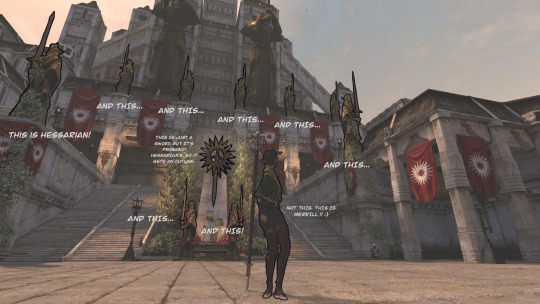
here’s merrill examing the architecture of the kirkwall chantry. and it’s covered in this guy!

how do we know this guy is hessarian? let’s compare it to some other, canonical andrastion depictions of the latecomer disciple. hessarian is typically depicted with some type of crown or headwear to demonstrate his status in tevinter, robes to denote him as a mage, a long beard probably also symbolic of tevinter culture at the time, and, of course, his blade of mercy. we can see all of these on the figure repeatedly shown in and outside the kirkwall chantry, as well as a certain similarity in the face to the other depictions.
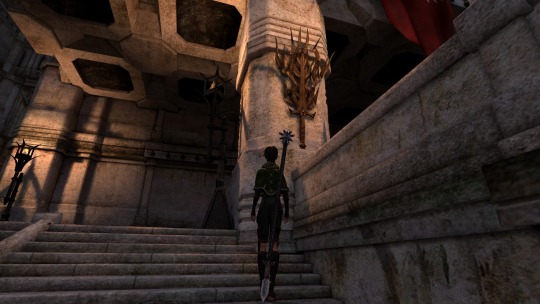
here’s another variant of how the kirkwall chantry depicts the blade of mercy! these are Everywhere, including right over the doors.

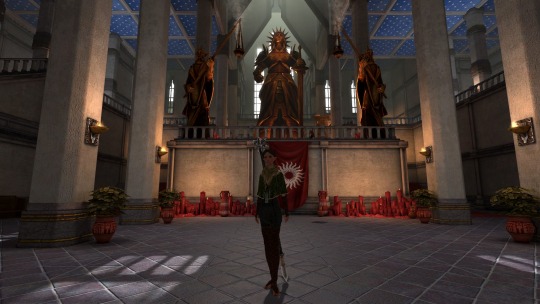
and here’s more variants of the same figure inside. he’s carrying some kind of incense burner instead of a sword here, but it’s clearly the same face with the same crown and that classic hessarian beard. note his position of power flanking the enormous andraste figure.
so... why does that matter? isn’t it just a repeated asset?
no, it’s CRAZY actually. and here’s a couple reasons why!
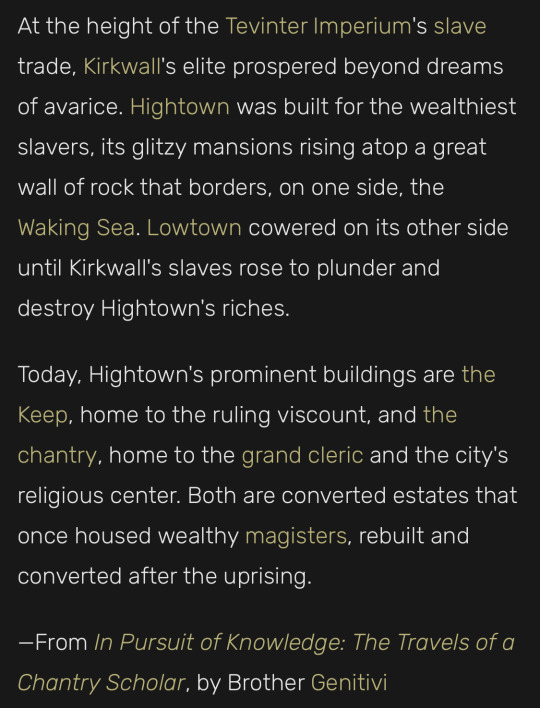
(fascinated by genitivi’s word choice of glitzy mansions, btw.)
firstly, the kirkwall chantry’s dedication to hessarian’s figure is one of the biggest markers that it, along with the gallows and the darkspawn, is a legacy of tevinter. as i said, he’s the favourite there. kirkwall was once emerius under tevinter’s rule, and from the moment we see the weeping twins that welcome you into the city, we’re supposed to remember that the city of chains has not changed all that much. just as emerius’ prisons now incarcerate mages, its industry is now powered by refugees, and the worst parts of its lowtown hold elves probably just as they once did, its magisters’ estates continue to hold the most powerful voices in the city: in this case, that of the chantry and grand cleric elthina. the hessarian statues that demonstrate the chantry’s wealth and power are inarguably either tevinter made or at least made in their style, with such similarity to the statues of slaves that terrorise the gallows courtyard. hightown is no more free of that inheritance than the circle.
secondly, the focus on hessarian can’t be an accident in dragon age 2, a game obsessed with the mercy kill. “without an end, there can be no peace,” says flemeth. somebody has to kill wesley rather than watch him turn into a ghoul. anders has to kill karl. hawke possibly has to kill their other sibling if they catch the taint in the deep roads. varric can kill bartrand when he goes insane. killing the serial killer of elven children rather than letting his madness continue is one of the most universally approved decisions in the game. in her last words, leandra thanks you for ending the mage keeping her alive with twisted necromancy, even if, and especially because, it means the end of her suffering in death. merrill has to kill a possessed keeper marethari. many more can be killed for being “too dangerous” to live, like the blood mage idunna. orsino is slain by hawke after transforming into a monster he would never have wanted to be. there’s probably a dozen more examples i can think of. and of course, in one of the most game-defining decisions hawke has to make, there’s the option to kill anders after the destruction of the kirkwall chantry. merciful is not the word i would use for that, but it has certainly been framed that way. i suppose that’s the same as what i think of hessarian’s actions, isn’t it? (we’re focusing on the andrastian relevance here and not the godawful treatment of mentally ill people in this game, btw, although. yikes.)
“don’t compare yourself to andraste,” says sebastian to anders. he could try telling the game that. hawke gets cast into a lot of roles, but when anders believes they will kill him, he’s casting himself as the martyred andraste, dying to burn rebellion into the face of thedas, and hawke as his hessarian, quick with the merciful blade. i suppose it’s fitting that the kirkwall chantry should be consecrated in the image of its champion. and that the chantry covered in that image gets destroyed moments before hawke makes their choice, if they decide to make a different one. it’s also worth mentioning that meredith is a mimic of andraste, too, with her stolen crown, making anders and meredith obvious combatants for andraste’s legacy in the game. hawke doesn’t get much command of the narrative, but maybe they can at least dodge being anders’ hessarian, if they choose.
idk i think it’s really fucking cool and we should talk about it more, basically! there’s a lot of other angles to take. hessarian is such a fun lore figure to explore. for example, i didn’t even get into the prominence of an andrastian mage figure here, or that the blade of mercy is the symbol of the templar order and was invoked even earlier, in dao, as the “blade of mercy” by traumatised mages who desperately sought to be purified by the templars’ judgement.
also, i think ‘the chantry of hessarian’s mercy’ sounds good. maybe ‘the chantry of our lady’s spilled blood’? that could be sexy. whatever. i’m workshopping it
#long post#kirkwall#anders#i’ve been to the church on spilled blood in st petersburg it’s so extraordinary
381 notes
·
View notes
Text
One bit of obscure Dragon Age lore a day until Dragon Age: The Veilguard is released
The Steel Age was named in recognition of the dramatic and mysterious death of Queen Madrigal of Antiva, whose body was found in a forest stabbed through the chest with four steel blades. One of these blades was a replica of the Blade of Mercy, a legendary sword used by Archon Hessarian to put Andraste out of misery as she burned on the pyre.
According to one legend, Madrigal rode out into the forest alone to bargain with a Witch of the Wilds called Yavana. Madrigal was informed earlier by the Witch that she and her young son, Prince Eladio, would soon die. When Eladio became gravely ill, his mother went to meet Yavana - and there Madrigal died. Eladio recovered from sickness, but then vanished without a trace - only a year before his adulthood and the awaited coronation.
Source: Codex entry: Blade of Mercy, Dragon Age: The World of Thedas, vol. 2, p. 46
Previous bit
38 notes
·
View notes
Text
Andrastian Design: Stained Glasses
The Stained glasses of the Chantry that appear in DAI seem to narrate the main passages of the Chant of Light [for more details read Part 1 and Part 2]. I’m not so sure to relate them to Serault glasses, since the style is different.

The interpretation of these glasses is done under the hypothesis that their design may hide in plain sight details or elements from ancient tales that were used to create the Chant of Light [for example, we can notice the presence of Elvhenan elements in it since the tale of the Maker has strong resemblance with the Elvhenan tale of Fen’Harel when it comes to seal entities that endanger The People]. This makes sense because this a game, where the devs may have given to us small hints to pick in the art that we may feel a bit odd if we keep only the Chant of Light as the only source of explanation for this iconography.
I’m also working on this post under the hypothesis that these images in the stained glasses are as old as the tale of Andraste, as if they had been created by local andrastian cults that the Chantry, once founded, embraced in order to keep all the different andrastian cults under a single institution or to attract other religions that would see their same or similar iconography in it. Sadly, we were never informed the date of these stained glasses and their iconography to be sure about this hypothesis.
[Index page of Dragon Age Lore]
The Magisters perform blood magic rituals and taint the Golden City
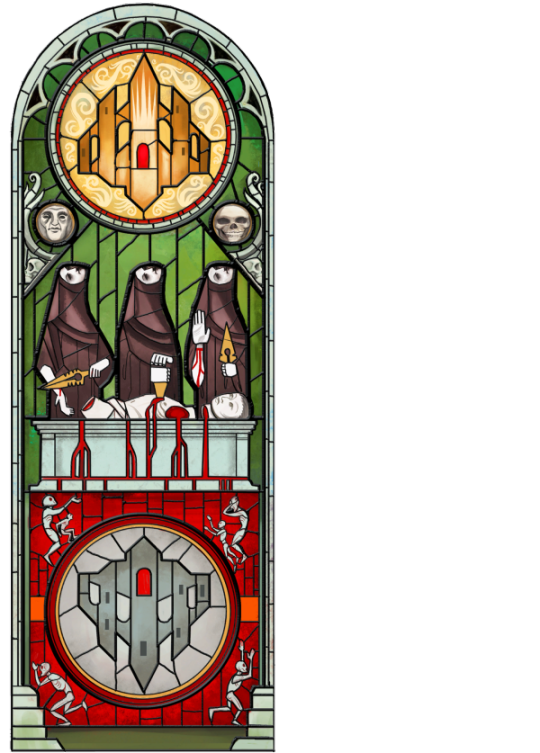
The colour of this glass is predominantly green and red.
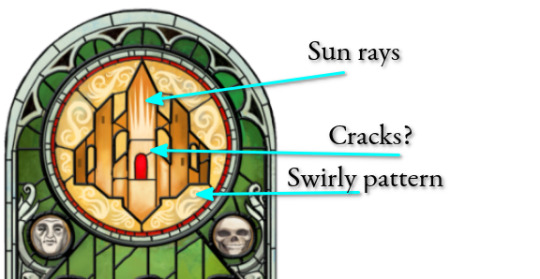
At the top of the glass the Golden City is placed, with a small detail of sun rays on the central tower and apparently some cracks in its walls since it’s more fragmented than the black version below [this could also be the stained glass style though]. Around it there are several swirly patterns, and a double circle encloses everything as if it were protected by a barrier. This may represent the Barrier that isolates the Black City, where neither dreamers nor spirits can enter [more details in Murals in DAI: Basics].
Below, there are two small circles: one with the face of a man, the other, with a skull.

In the middle of the image we see Magisters Sidereal, using sacrificial daggers that curiously looks like Swords of Mercy [not the one used by Fenris in DA2 but the one depicted in Chantry iconography and in the Female Kossith/ Desire demon /Tevinter Warrior]
The Magisters perform the sacrifice, and through blood magic, which includes their own blood, they manage to “spill” blood all around the Golden City turning it into black, and putting it upside-down with the exception of the red gate that remains in the same position. The Golden City loses its colours and swirly patterns; now it’s Black, and the barrier that surrounds it is red and yellow. The whole Black City is submerged in an ocean of blood.

At the corners of the Black City there are several white slaves commonly depicted in Kirkwall iconography. This may be another dev-hint to reinforce the idea that Kirkwall was truly where this event occurred.
This scene represents the verses Silence 1-3 [ Chant of Light - Part 1] where the Magisters commit the second sin: they enter the Golden City through rituals of lyrium and blood magic with 99 sacrifices [probably more than that] and “taint” it, according to the Andrastian myth. It is curious that the image does not show the entrance to the city through a bridge of flesh raising to the skies as the "dissonant verses” explain. Instead, the Black City is located underground. It could be considered a normal limitation of the lack of space to draw this picture, but it also inspires this idea hinted in Veilfire Runes in the Deep Roads that something terrible is underground, collapsed, and hidden, so nobody would use it [or in my opinion, nobody would cause its reflection in the Fade].
The Maker speaks to Andraste
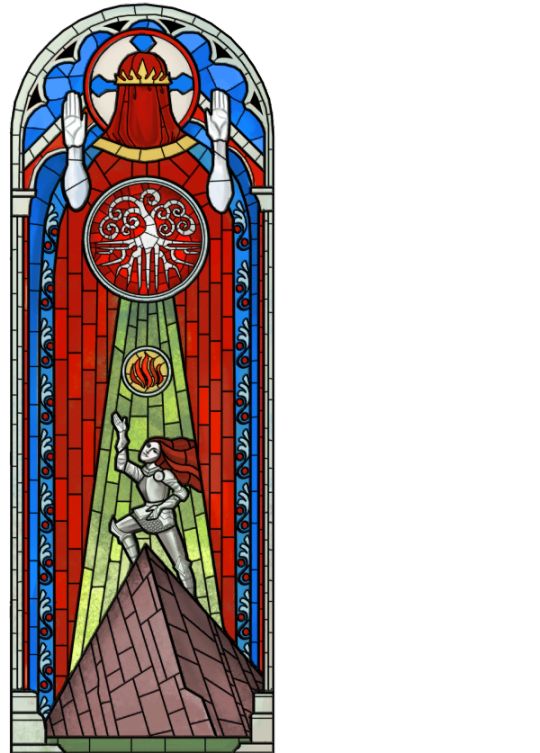
The colour of this glass is predominantly blue and red, with a central green ray.

Here, we find a figure without face and a crown that represents the Maker; we had seen this same concept in other pieces of art in what I called Faceless figure holding a crown. It took me a while to realise this sculpture was the representation of the Maker so forgive the tag name.
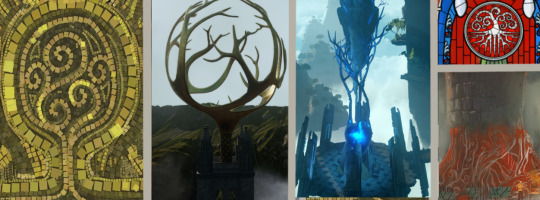
Around the Maker’s heart appears a swirly tree that seems to be contained in a circular barrier. This brings strong reminiscences of the mosaics in the Fen’Harel’s mountain ruins, where we find some common designs between the Vhenadahl, Elven Tree Statue, the titan’s guardian’s heart, and dimensional pockets, all of them related to magic, lyrium veins, and spaces in-between the Fade and the Waking World. In Fen’Harel’s mountain ruins, I explained in detail that it doesn’t seem to be odd that the Fen’Harel mosaic which features an object that could be interpreted as a pocket space and also as a spherical elven tree [both symbols of power that may or may not be related to lyrium] appear later in this stained glass, in a very similar fashion to the symbols drawn on the Vhenadahl’s trunk of some alienages.
How do we explain this without wild weird theories? Simply as the natural evolution of tales and symbols across history, modified by generations due to the inaccurate nature of the oral tradition. We could speculate that elvhenan survivors and former slaves of the Evanuris who found refuge in Fen’Harel may have kept Fen’Harel’s legend alive throughout history, despite the creation of the Veil and the posterior slavery of Tevinter.
We know via Veilfire Runes in the Deep Roads that “something angry”, described as a “sphere of fire”, is hidden underground. It’s hard to tell how much of this knowledge leaked into the general unconsciousness of the free elvhenan slaves, since Solas always wanted to hide this piece of history, fearing others would use it to claim power. But I think some details reached the elvhenan free slaves [maybe as fantasy cautionary tales] who passed that knowledge to other generations when they lost their immortality and the symbol ended up in the Vhenadahl being decorated with a red trunk and white branches/vines. Since this knowledge seems to be related to elves and the “old ways” [according to the elves from the alienage] one could suspect this element was developed around the time of the Dalish Kingdom in the Dales, where the Chantry was still creating its Chant by absorbing a lot of elements from different folktales [see The Chantry and the Mythology of the Chant of Light for more details]. So it seems that the Chantry may have also taken something of this idea of a “powerful and dangerous tree” and turned into this symbol: a white tree in a red sphere that represents the Maker’s heart, something they fear but also consider it dear [from a religious point of view].

In another interpretation, considering its root symmetry, we may consider this tree-symbol as a representation of Mythal, simply because it has some distant similarities with the Vallaslin [leaf-free tree]. In fact, since DAO we have been seeing a constant symbology of a tree, losing its leaves, which had a similar design to one of the old Vallaslins that may represent Mythal’s.
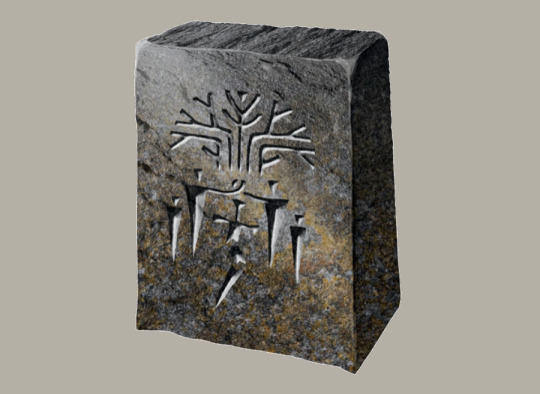
There is also a symbol of a tree which upper part looks similar to the roots of the maker’s tree; it is a tree of peace that was cut to make a war table in Skyhold that may or may not relate to some original tale or event that can be linked to this old symbol of a tree in the stained glass. [More details about the tree symbols in Murals in DAI: Red Lyrium Idol]. Sadly, we know nothing more about this symbol, so we can’t speculate much either.
Continuing with the stained glass, this strange circle that contains a swirly tree drops a ray of green light [colour similar to the Fade if we follow the colours in the most naive, simple way and exclusively from a design point of view]. This could even suggest that Andraste talked to the Maker through the Fade [something we have been suspecting for a while since some events in Andraste’s life make us consider her as a potential mage], which gives the idea that the Maker could have been any spirit, and Andraste spoke to it in a similar fashion as alamarri/Avvar mages do [which would make a lot of sense since she was part of the alamarri culture that did not punish magic and tended to contact spirits for counsel].
In the field of speculations, it would not be super strange that this Maker were Mythal herself too. We know she has talked to others through dreams: she may have called Kieran in this way, but we also know that there is an elf in Val Royeaux who claims to have been visited by Mythal in dreams and after that conversation, he has his face burned with her vallaslin [Elven Servant Dreams of Mythal, another videos here]. So, this detail in the glass may hide a situation of the like. Or maybe not. We are here reading too much into everything, after all.

Andraste extends her hand to reach a “sphere of fire”. We know how disturbing a “sphere of fire” is for the elvhenan; we have been discussing this for a long while in the series of Murals in DAI in general, and in The Creation of the Veil and in The Death of a Titan in particular. Somehow, the andrastian myth managed to have that exact symbol representing faith and cleansing [we also know that Andraste was always deeply related to fire, since in her Temple, she asks those worthy to cross a wall of flame, more details in “ Temple of Andraste”].
It also worth noting that this icon is deeply related to magic [a human with a flame close to their hands is a good representation of a mage] but the Chantry may have dismissed and erased any potential interpretation related to magic due to its agenda since the beginning to prevent the creation of any other nation similar to Tevinter [filled with free mages].
Another interpretation is that this “swirly tree”, so related to Magic in the elvhenan culture, drops a green Fade-like coloured ray onto her and grants her or gives her a “sphere of fire”, that could represent magic power. This has so many different interpretations of what could have been if Andraste were a mage, a dreamer or even a host for Mythal. Sadly, all those speculations fit in an interesting way here but none has too much support outside the iconography of this glass alone. However, I must say, that the environment around Andraste favours a lot the speculation of her being a mage [I mean, the Alamarri may have a similar approach to mages than the Avvar].
From an Andrastian point of view, this stained glass represents Andraste receiving or showing her fiery faith in the Maker, as she speaks to him, or to his heart. Still in this interpretation the symbols of a swirly tree in the heart of the Maker is very strange.
She is also standing on something that looks like a mountain. All over this image, we see the mantle of the Maker [blue with a small berries-like pattern] falls all upon her. This mantle will appear again in Andraste’s ascension, in the last stained glass.
The verses that this stained glass represents are Andraste 1 [Chant of Light - Part 1], in which there is no mention of any tree making this symbol even more curious in this stained glass.
With Maferath, Andraste leads the alamarri armies against Tevinter

The colour of this glass is predominantly orange and red, with blue.
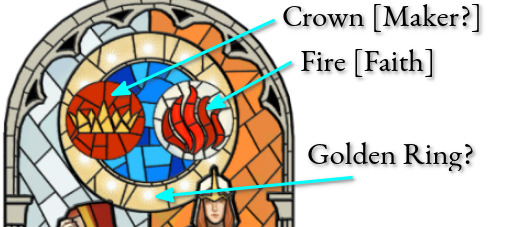
The top of the stained glass shows two spheres: one with a golden crown [that I think it represents the Maker, since it’s a similar crown to the one he is wearing in the previous stained glass and in his other representations], and the other with fire as a representation of Andraste’s faith. Both “spheres” are on a golden circle that looks like a Golden Ring. Notice that it has a patterns of small Chantry suns repeated on it. Inside the ring, we see blue glass which may be interpreted as something related to lyrium? It’s a bit disturbing for me to see the Golden Ring containing a pool of water-lyrium, and then, on the bottom of the piece, several men that look like avvar/alamarri warriors painted in the same colour. In an Elvhenan context, this would mean servants or slaved. Here, it’s not clear if this meaning has survived when the Chantry adapted the elvhenan details and symbols to their own purposes, and to what extend they did it.
I insist in doing these connections because we know that the Chantry is a mash-up of previous religions and symbols, so there is a chance for all these symbols to be distantly related to Elvhenan or others.
In an Elvhenan context, the Golden Ring seemed to imply control of masses [more details in Nation Art: Elvhen], and the presence of this water-lyrium pool reinforces the idea of control when each of the soldiers is coloured with the same blue. It’s also curious all of them are drawn below two diagonal lines that seem to imply mountains. So these warriors look like being below the mountain. Does any of this makes sense in the context of the Chantry? no. But I would not be surprised that part of these symbols were co-opted and adapted from ancient symbols. For example, look at the similarities of the design of this stained glass:

The configuration of this particular stained glass reminds me of the Stone in Razikale-Ceremony-style [which despite being found in ancient Tevinter buildings, it seems to have an elvhenan origin that we cannot precise as we discussed in Razikale Ceremony and Dumat’s Warrior tablets]. Instead of focusing this stained glass on Andraste as an equivalent of this High Priest of Razikale, it focuses on Maferath and Andraste. The symbols of the Maker and the Faith have the same place than the strange skull in the tablet. At the lower half of the piece we find the devote warriors of Andraste, while in the tablet, there are priests of Razikale and some warriors. Again, I’m not saying this is the same representation nor that there exist a non-unequivocally equivalence between these pieces of art. I’m just considering how the tablet, of Elvhenan origin adapted to Tevinter needs later, may have been incorporated in the symbology of the Chantry to bring faithful of previous religions to this one, showing familiar, appealing images [again, this is how religion has been working in our world, specially when it comes about evangelisation during colonisation procedures].
The general interpretation of this stained glass is simple: the central part show the main two figures responsible of the Exalted March against Tevinter: Andraste and Masferath. Both are under the symbols of the Maker and the Faith, the “true” powers of this couple. Maferath is depicted as if he was getting tired of Andraste “leading” this Exalted March. He places his hand on her shoulder as a way to try to stop her, but Andraste is depicted too stoic and determined in her goal. Below them, armies of loyal/devout alamarri warriors, painted in a colour that is related to the background of the symbols of Faith and the Maker, maybe as a way to represent that they are guided, ultimately, by “the sun” that the Maker represents.
The verses that this stained glass refers to are not clear in the Chant of Light we were given. I don’t find a particular group of verses where Andraste narrates her movement across Ferelden and the Waking Sea to invade Tevinter lands. The closest verse to this action is Shartan Verses [Chant of Light - Part 2] but also this historical event is implied in Hymns and Transfigurations ]Chant of Light - Part 1] where Andraste prays to the Maker before some battles. It is curious that there is no verses about the “travelling” part of Andraste and her armies, not even when crossing the Waking Sea.
The Fall of Tevinter Imperium
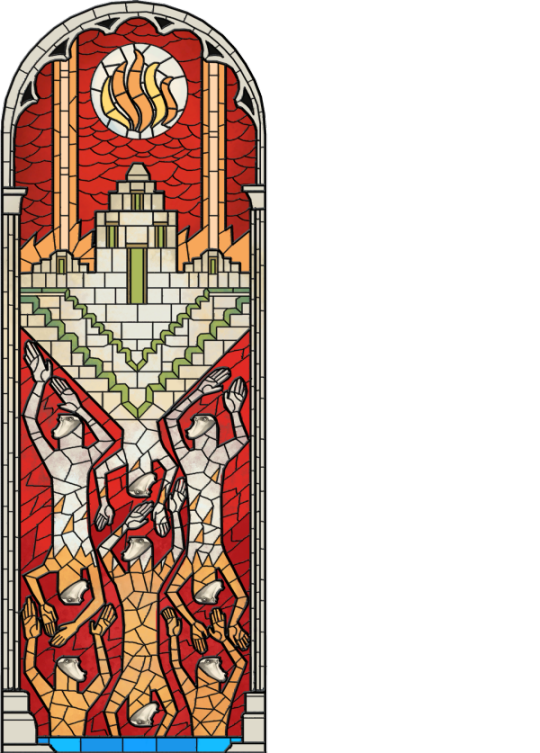
The colour of this glass is predominantly orange and red.
This glass seems to represent the siege of Minrathous or maybe another important city. To be honest, I never understood well the event that DA series calls “the siege of Minrathous”, because that siege never happened, since Andraste was betrayed and handed over to Tevinter after talking to her armies but before the siege itself. In any case, we can consider it a generic Tevinter city.
Anyways, on the top of the image we see the sphere of fire, a representation of Faith, enormous and powerful hitting hard on the city which turns into flames [red everywhere]. Two rays fall upon the city buildings, and the Tevinters, represented as those screaming people who are part of the city itself, burn with the fire of the faith that this Exalted March has brought. In order to snuff out the fire of their bodies, they sink into the water barely noticeable in the lower part of the glass. I don’t think there is nothing extra to analyse in this one.
However, if we see this image with Elvhenan eyes, we may suspect it as a prophecy, in which the “sphere of fire” raises to the skies and the world is burnt with its anger. The reckoning comes from the skies, almost as if this were the revenge that Mythal awaited for so long [I always remember Flemeth’s words: “She was betrayed as I was betrayed – as the world was betrayed […] and I will see her avenged! [...] a reckoning that will shake the very heavens”]. But then again, this is just another interpretation with an Elvhenan perspective seeing this image that may or may not have had this intention from the devs.
This particular scene is too generic to represent a particular verse of the Chant of Light. It’s a symbol of the army power that Andraste led in the andrastian myth. Maybe it can even be a cautionary image: “this is what an Exalted March looks like”, it seems to say, and maybe this symbol have put some pressure in the consciousness of the elves that ended up living in city alienages but their resentment for the failing of the Dalish Kingom was still too fresh. Certainly, it’s a pretty raw image.
Shartan as part of Andraste’s forces
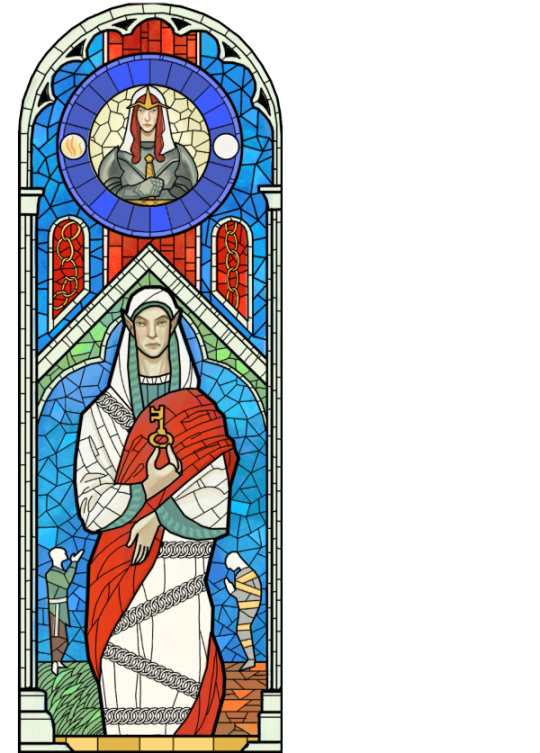
The predominance of blue in this glass is interesting due to the potential implications with lyrium and eluvians.
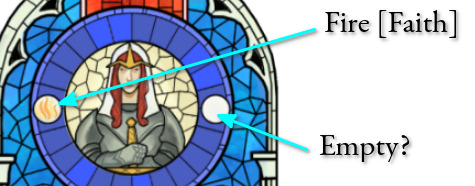
At the top of the glass we see a ring, but this time is coloured in a deep blue, which contains two spheres: one with Fire, as representation of the Faith in the Maker, and another one empty [????]. Andraste is in the centre and above Shartan to represent her as higher in the hierarchy of the forces; she is after all, the “prophet”.

A bit below, we see chains in the red windows, the symbol of slavery without any doubt. These chains are a bit different to the one that wraps Shartan. That chain looks like chain-mail, which is used in Chantry-like illustrations. For example, the Tarot card of Justinia V represents her necklace with the Chantry-sun using this type of chain. It’s quite interesting that this chain is restraining Shartan. In a simple glance one would interpret it as the chains of slavery, but they are the ones related to the Chantry while holding a key. Inside an Elvhenan context, this figure would mean that Shartan had the key of some eluvians, and the Chantry, restraining him, forced him to be part of this Exalted March and even use it to cover long extensions of terrain.
Another interpretation is that Shartan is represented as a vital key in the Exalted March against Tevinter: he has the key of victory, although he is very restrained by the Chantry itself. This may be a representation of the verses that have been “lost” or removed from the Chant. It’s a strange picture that does not seem to reflect any verse when we only have Shartan 9 and 10 [Chant of Light - Part 2].

On the background, we see slaves [I assume so because the shape of their heads is almost the same than the ones depicted in Kirkwall]. One of them is free, wearing green/brown earthy humble clothes, standing on grass, lifting their hand towards Shartan. The other is a slave, wrapped in white clothes and yellow chains? They seem to be a potential victim of a sacrifice. They are praying to Shartan and lowering their head in front of him. Curiously, Shartan and this figure have similar wrapping. This wrapping is negative as we can see in the next stained glass.
Even though we have the verses of Shartan 9 and 10 in the non-canon Chant [Chant of Light - Part 2], none of them seem to have inspired this image. To me, it’s related to the role that elves had in the history of Andraste’s march, but it’s not clear in what manner. Hence my suspicion that this image may represent the lost verses that scholars suspect exist in between 9 and 10. This, of course, would be a hint given by the devs.
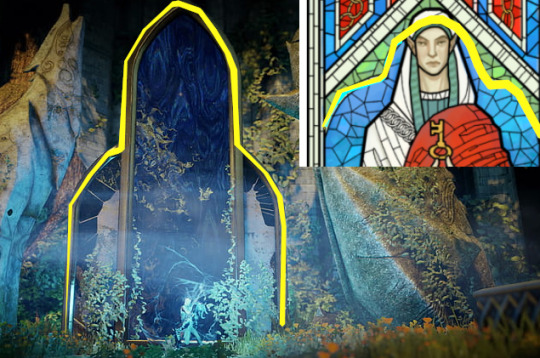
Based on my own personal speculation, I think this part may speak of “elven magic” allowing to “teleport” Andraste’s armies using the eluvians. Eluvians are always “locked doors” that can be unlock with a correct key [sometimes a password, sometime an object that works as a key], so the fact that this elf is holding a key in his hand is basically telling me that the devs are suggesting that eluvians were involved in this part of the story. To emphasise that from a design point of view, we can see a very subtle outline of an eluvian at the background, coloured in blue [as eluvians are when they are active].
Why would the Chantry remove a verse explaining that the elves allowed Andraste’s armies to use eluvians? simply put: because it looks like elven magic allows teleportation. This breaks one of the three main [Chantry] rules of magic [since DAO] that Thedas holds as something you cannot violate without disastrous consequences: No teleportation, no physical entrance to the Fade, and no immortality [all of them explained in the codex The Cardinal Rules of Magic]. Ironically, as we can see once we reach DAI, all of them are bullshit: it’s more Chantry misunderstanding of how the world of Thedas is and works. Elvhenan magic and Elvhenan nature are intrinsically the violation of all those rules, so it makes sense for me that the Chantry removed any potential verse that may implicate the fact that there are ways to transport people long distances through the eluvians.
Maferath hands Andraste over to Tevinter
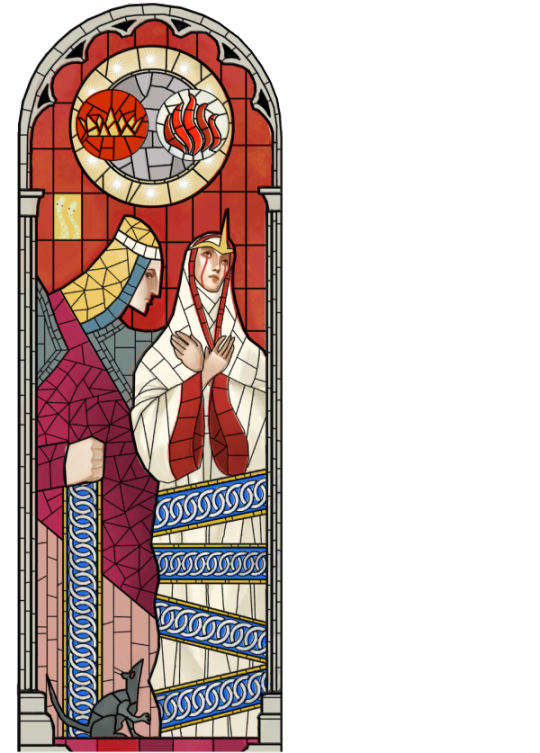
The colour of this glass is predominantly red with accentuated blue.
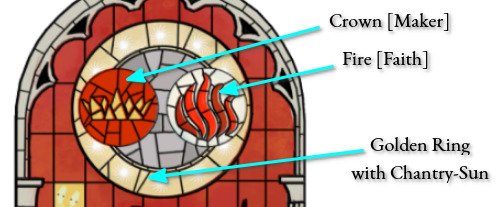
At the top of the glass we see once more the Golden Ring [now in a pale yellow] with the two spheres: fire and a crown that we know they stand for Faith and Maker, respectively. The inner background of the Golden ring now is grey, assuming it’s a way to interpret that the Faith in the Maker has been diminished, at least on Masferath’s part since here we see when he hands Andraste over to the Archon.

In the main central piece we see Maferath holding a Chantry chain as if it were a sword that will decide Andraste’s fate. Since Andraste is wrapped in this chain, this represents the “betrayal”. Maferath chains Andraste and hands her over to Tevinter. These chains are in blue, standing out from the glass which has been painted predominantly in warm colours.

There is a small tile in the background where we see two small snakes in yellow, suggesting this action was a consequence of a “whisper” of Tevinter or a secret arranged between Maferath and the Archon, so two snakes are behind this event.
Andraste is crying blood and she is wearing her typical crown of a single spike. She still looks upwards, to the Maker and the Faith symbols.
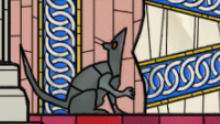
Down below we see a rat, which is curious because I can’t find a significant interpretation to this: Masferath is a rat? XD This kind of details spark wild conspiracy theories. I won’t go there, but certainly I would like to know what’s the design purpose of putting it in the foreground. The snakes representing the secret meeting of Maferath with the Archon is less relevant than this rat. Lol.
This stained glass represents the verse of Apotheosis 1 [Chant of Light - Part 2].
Andraste is burnt publicly and Archon Hessarian kills her out of mercy

The colour of this glass is predominantly red and brown.
Here we find the stained glass separated into two. The foreground is dominated by Archon Hessairan who is presented with a Tevinter outfit and two golden snake raising to his side, probably as a representation of the original “betrayal” he encouraged Masferath to do.
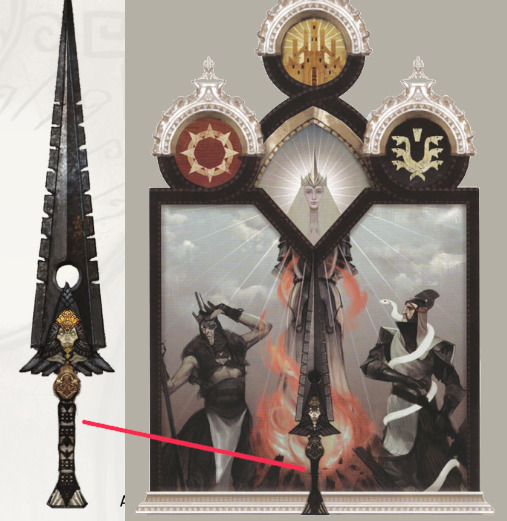
He is killing Andraste out of mercy with a sword that doesn’t look like the usual one they depict as the “Sword of Mercy”. However, we see this sword in the “Tevinter warrior” that decorates the columns of the Imperial Highway: check the Female Kossith/ Desire demon /Tevinter Warrior tag.
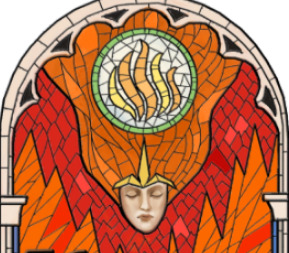
On the background, we see Andraste being beheaded. This is curious because the verses and the most common depictions show her death being caused by the sword piercing her chest/heart. This makes us wonder if these stained glasses have more information than the verses [which I think they do since Shartan’s stained glass implicates a lot of more things than those said in the Chant]. The background behind Andraste is full of red and fire to represent the pyre. She is also wearing her typical one-spiked crown. In her hair, at the top of the image, we see the sphere of fire once more: the symbol of Faith, bigger than in the other cases, probably as a representation of her determined faith [but also, from an Elvhenan point of view, it’s a symbol of something terrible and angry].

Curiously, in the background, at the middle of the glass, we find the crown that we assumed it represented the Maker, but it’s not inside a sphere anymore, but inside an inverted triangle painted in green. The inverted triangle may suggest the Maker came down from the skies to take Andraste’s soul?
In an elvhenan context, this elongated inverted triangle would mean the presence of the Fade in this event. Its colour is the same one than the “green ray” coming from the swirly tree/ heart of the Maker that we saw before. Is this a symbol showing that the presence of the Maker was here during this episode?
If we assume that Andraste was a mage, possessed by a spirit that kept her safe and taught her magic, this symbol may represent that this spirit [which has been talking to her and working as “The Maker”] left her body in that moment. Now, these interpretations can go as wild as we want, but at the end of the day is hard to appraise which is the better one, since we don’t know how old these stained glasses are, and if our hypothesis that there may be some elvhenan symbols is correct.
The verse that this stained glass reprsents is Apotheosis 2 [Chant of Light - Part 2]
Andraste ascends her mortal form

The colour of this glass is predominantly yellow. If yellow can be understood as golden, and we add more meaning to these stained glasses by embracind the elvhenan iconography, this may be telling us that Andraste reached divinity.
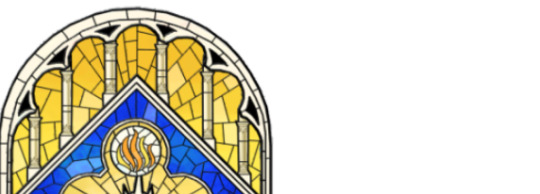
In the final stained glass, we find the ascension of Andraste: her background is entirely yellow/golden. At the top of the glass we see some columns and a structure that suggests a roof, implying she reached the Golden City.

She is wearing her crown, but now it has 3 spikes. She seems to be bald now since we don’t see any bit of hair [that’s what pyres do even in the afterlife, I guess]. Over her head is always present the sphere of fire representing her never-ending Faith. At the sides of her face, we find two inverted triangles. One in blue, representing the Maker with his crown inside, and the other in red, representing a sword [that I think it’s similar to the one used by the Archon in the previous glass]. This may represent that through an act that spilled blood [being killed by a sword] she reached the Maker. But these triangles could also be used to “remember” her as a warrior as well as the bride of the Maker. I don’t know, the interpretation gets a bit diversified here. The red stands out and it related to the “earth”, since at the lowest part of the stained glass we see the ground painted in the same colour.
She is wearing a white robe with a golden scarf, reinforcing the idea of bride and purity [cleansed by the fire], as she is emerging from the mountains, interpreting this as her ascension to the Maker’s side [the Maker has appeared to her behind the top of the mountains, according to Andraste 1].
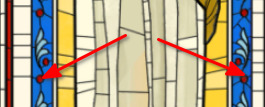
The sides of the glass show a pattern of “berries”, which are in the same style that the ones we saw in the Maker’s mantle in the first glass. This may indicate she is under the roof/mantle of the Maker now.
The verse represented in this image is the last part of Apotheosis 2 [Chant of Light - Part 2]

In the book World of Thedas, we find a concept art of a Chantry, which ground is what caught my attention the most: we find a Quincunx, a symbol that long ago we had found in a repetitive way all over DAO and had disappeared after DA Awakening. In DAI reappeared in Solas’ tarot card and in some elements of Orlesian Design, but never got the relevance it had once in DAO.
In here, we see the centre focused on the Golden City, while the other four points display the crown of the Maker.
#Quincunx#chantry#stained glass#the chantry#andraste#maferath#archon hessarian#hessarian#maker#andrastian design
34 notes
·
View notes
Text
I love Meredith’s Andraste complex and I think it’s especially fun when paired with a Hawke who keeps usurping her position in moments of religious embolism. I think it would do really well narratively to sort of indicate how the chantry has strayed from the path of good and righteousness by having this literal representative of the might and reach of the chantry be in constant direct opposition to your actions (at least when you’re pro-mage)  but then at the crescendo of each minor conflict, it’s Hawke who is sort of takes the place of the Andraste voice piece or figure. Additionally though, just character wise specifically for Meredith - I just imagine a roaring end to Act II where Meredith is marching up to the keep ready to take up the role of Andraste-figure-savior-protector and opening the doors to a Hawke already engaged with the enemy and being run through by his blade. Believing that she is about to affirm her inhabitance of this sort of Andraste-esque idolatry only to open the doors and find out that not only has she been denied, she’s late to the party - Andraste was already thrown on the pyre and Hessarian is cutting her down. And there is not even the cold comfort of a revisionist history or her being able to bury the moment deeper than anyone can find, because Act III? It’s what would have happened if Andraste had stepped down from her pyre and away from the sword afterwards. It’s an abomination, it’s heretical, it’s her obsession. (It’s everything she wanted to be.)
#meredith stannard#da2#hawke#Andraste#I just love character complexes and pressing on them like an old bruise#and for you who go there#it’s quite interesting from#this perspective what role the Arishok holds
70 notes
·
View notes
Text
Day #2: Andraste's Mabari
You know Andraste's old mabari.
He don't show up in the Chant.
And if you ask those holy sisters,
Well, they'll say Andraste can't
Have had some big old smelly wardog.
But all Ferelden knows it right:
Our sweet Lady needed someone
Who would warm her feet at night.
And there's Andraste's mabari
By the Holy Prophet's side.
In the fight against Tevinter,
That dog would never hide.
They say the Maker sent him special,
Always loyal, without pride,
So he could be the sworn companion
Of the Maker's Holy Bride.
Oh, that dog, he guards Andraste
Without arrogance or fear,
Only asking of his mistress
Just a scratch behind the ears.
But then old Maf'rath gets to plotting,
Tries to lure that dog away.
But even as they trap the Prophet,
Her mabari never strays.
And there's Andraste's mabari
By the Holy Prophet's side.
In the fight against Tevinter,
That dog would never hide.
They say the Maker sent him special,
Always loyal, without pride,
So he could be the sworn companion
Of the Maker's Holy Bride.
Oh they thought the wounds had killed him,
But then he limped out toward the fire.
And Hessarian, he shed a tear,
As that dog laid on the pyre.
And there's Andraste's mabari
By the Holy Prophet's side.
In the fight against Tevinter,
That dog would never hide.
They say the Maker sent him special,
Always loyal, without pride,
So he could be the sworn companion
Of the Maker's Holy Bride.
Yes that mabari's the companion
Of the Maker's Holy Bride.
—A popular, if historically unlikely, Fereldan tavern song
#this wasn't actually going to be today's entry#but I was thinking that Andraste really should have had a mabari#first she's an alamarri warrior#second we THINK mabari hounds came either from the imperium or descendents from Dane's hounds#and I'll admit I don't know if the dates would match then#probably not#BUT#we aren't sure#so my hc about Andraste's mabari still stands#dragon age#dragon age 4#dragon age the veilguard#dragon age dreadwolf#da4#if you don't know why i'm tagging datv it's because this is a codex countdown
25 notes
·
View notes
Text
Yeah that little freak that the Herald is fucking is talking about Maferath a lot again. which could mean nothing.
12 notes
·
View notes
Text
headcanon generator tag
hello @foxboyclit i got tagged in this and immediately had too much fun generating shit for everyone lmao
Rules: use this headcanon generator to make headcanons for your OCs! Then talk about how accurate they are.
Gideon has a Mary Sue OC
Gideon specifically has a self-insert mary sue OC! possibly several!
Severin believes in ghosts and insists on trying to summon one at every sleepover
Absolutely!! She is pulling out the Ouija board at every opportunity. They've got undead friends probably...... spirit ghosty coworkers in the Mourn Watch.
Sarian uses two in one shampoo and conditioner
Sarian is Gideon's Templar brother and a bit of a himbo and absolutely uses like a 5-in-1 shampoo/conditioner/bodywash/facewash/etc
Grant has punched a hole in a wall
He... has for sure, yeah. Mother Mother Wrecking Ball is on his playlist. Man is not good at handling his emotions
Cyril enjoys doing taxes
LMAOOO i mean....... I haven't thought about it... I think he does not mind doing them in the sense that he doesn't put them off like most people would. He is On Top of all paperwork shit in Drezen but also this man would have an accountant that files for him.
tagging: @lords-of-fortune @amatres @aztarion
#tag games#ch: gideon trevelyan#ch: grant hawke#ch: hessarian trevelyan#ch: severin#ch: cyril lodovka
4 notes
·
View notes